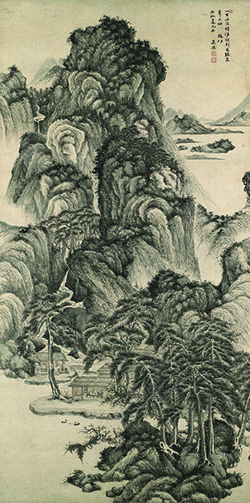In a work of WU Li 吳歷 (1632-1718), the landscape is emotionally charged, the painting as large as our body, literally filling our view. Compositionally, it is a rising, swelling space, with mountains like clouds of steam billowing upwards in fractal expansion. These are garlanded by an abundance of vegetation, the outer edges of the mountains teeming with trees, while others crowd the foreground.
The relative proportions of trees and rocks owe something to observation, but more to a rhetorical logic where size is used to emphasize. Waterfall-laden streams rush to a large pool at the base of the painting, punctuating the scene with lines of force.
The scene is realised with brushwork that is dense and lush, a spectrum of generous, wet greys. Even where the brush is pulled dryly over the paper, the effect is like polished metal. Finally, we are brought into this spectacle by avatars in a rustic building, left open in fine weather. This is an assured expression of satisfaction taken in the confluence of human and primal nature.
That Wu Li was also a Catholic priest (once active in Macau) is both a surprising thing to learn as well as suggestive of his imagination. Embracing a transcendental religious vocation may not be so different in the end from the sort of vision realised through this painting.
| | 
 |